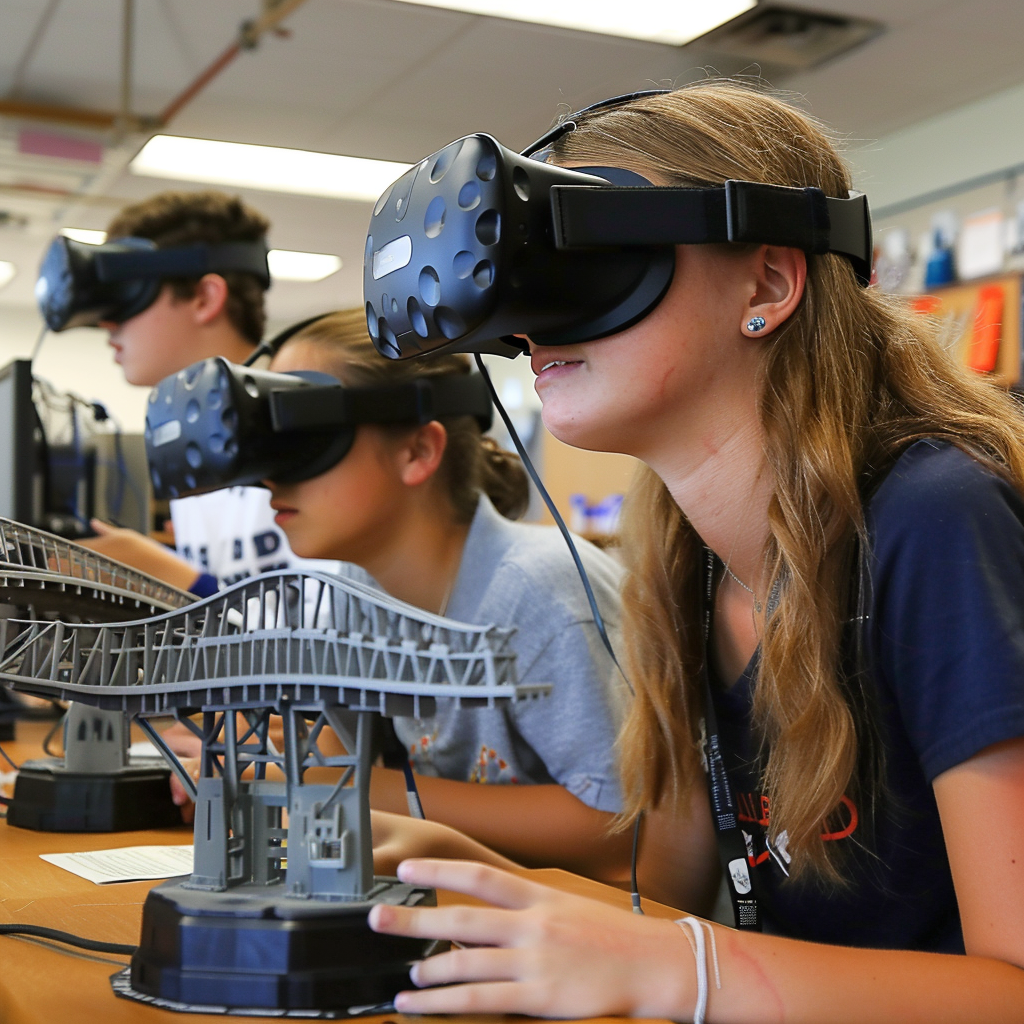Virtual Reality in STEM: Engaging Students with Immersive Learning
Elevate STEM lessons with VR: immersive simulations that boost engagement, deepen concept mastery, and inspire future innovators.

Imagine a classroom where students can explore the human body from the inside, design and test virtual bridges, or travel through space—all without leaving their seats. This is the transformative power of Virtual Reality (VR) in STEM education. VR is not just a futuristic concept; it is a present-day reality revolutionizing how we teach and learn. By making abstract concepts tangible and engaging, VR captivates students’ interest and enhances their understanding of complex subjects.
We will explore the benefits of VR in STEM education, provide practical implementation strategies, and showcase real-world case studies and future trends. Whether you’re a seasoned educator or new to the idea, this guide will inspire you to harness the potential of VR to create immersive, impactful learning experiences. Dive in and discover how VR can elevate STEM education to new heights.
The Benefits of Virtual Reality in STEM Education
VR has the potential to revolutionize STEM education by offering several unique benefits that enhance both teaching and learning experiences.
Enhanced Engagement: VR captivates students' interest by creating immersive and interactive learning environments. Traditional lectures and textbooks can sometimes struggle to maintain student attention, but VR's engaging simulations make learning fun and interactive. This heightened engagement can lead to increased motivation and enthusiasm for STEM subjects.
Immersive Learning Experiences: One of the standout features of VR is its ability to provide hands-on experiences without the physical constraints of a traditional classroom. For example, students can conduct virtual chemistry experiments, explore the depths of the ocean, or travel through space—all from their classroom. These immersive experiences make learning more tangible and can help students better understand and retain complex concepts.
Improved Understanding of Complex Concepts: STEM subjects often involve abstract and complex ideas that can be difficult for students to grasp. VR allows students to visualize these concepts in 3D and interact with them in real-time. For instance, understanding molecular structures, visualizing geometric shapes, or exploring engineering prototypes becomes much easier and more intuitive through VR. This visual and interactive approach helps deepen comprehension and encourages critical thinking.
Enjoy science fiction? Check out my space books HERE on Amazon!
VR in STEM education offers a dynamic and engaging way to enhance learning, making difficult concepts more accessible and enjoyable for students. By leveraging these benefits, educators can create more effective and inspiring STEM learning experiences.
Types of STEM Simulations with VR
VR offers a variety of simulations that enhance STEM education by making complex concepts accessible and engaging. Here are some practical examples:
- Virtual Chemistry Labs: Conduct safe, virtual experiments to observe chemical reactions.
- Biology Exploration: Explore 3D models of the human body, examining organs and systems.
- Physics Simulations: Visualize and interact with physical phenomena like gravity and motion.
- Astronomy Adventures: Travel through space to study planets and stars.
- Engineering Prototyping: Design and test engineering projects in a virtual environment.
- Robotics Programming: Program and control virtual robots to learn about automation.
- Mathematical Modeling: Manipulate 3D geometric shapes and explore functions.
- Environmental Science Studies: Simulate ecosystems and observe environmental changes.
- Geology Field Trips: Explore virtual geological sites to study rock formations.
- Data Visualization: Visualize complex data sets in 3D.
- Coding and Game Development: Learn coding by creating and testing VR applications.
- Circuit Design: Design and test virtual electronic circuits.
- Architectural Design: Create and explore architectural structures.
- Genetics and DNA: Study genetic structures through interactive simulations.
- Meteorology: Simulate weather patterns and understand meteorological concepts.
These VR simulations make STEM subjects more engaging and provide hands-on learning experiences that traditional methods often can't offer. Integrating VR into STEM education helps students understand and retain complex concepts more effectively.
Implementing VR in the Classroom
Implementing Virtual Reality (VR) in the classroom requires thoughtful planning and preparation to ensure a seamless integration into STEM education. The first step is selecting the right VR tools that align with your educational goals. There are numerous VR platforms and applications designed specifically for educational purposes, such as Google Expeditions and Labster, which offer a variety of STEM-related simulations. Evaluating these tools based on your curriculum needs and budget is crucial.
Setting up VR in the classroom involves ensuring you have the necessary hardware, such as VR headsets and compatible devices. It's important to allocate space where students can safely use VR equipment without obstructions. Consider starting with a small number of headsets and gradually expanding as you become more comfortable with the technology. Providing training and support for teachers is essential to effectively utilize VR in lessons. Professional development workshops, online courses, and collaboration with tech-savvy colleagues can help build confidence and proficiency.
Incorporating VR into your teaching requires aligning VR activities with curriculum standards and learning objectives. Plan lessons that integrate VR simulations to enhance traditional teaching methods, rather than replacing them. Additionally, ensure that there are clear guidelines for students on how to use the VR equipment safely and responsibly. By following these steps, teachers can successfully implement VR in their classrooms, creating an engaging and immersive learning environment for their students.
Designing Effective VR STEM Simulations
Designing effective VR STEM simulations involves aligning activities with curriculum standards and creating engaging, educational scenarios that capture students' interests. Begin by identifying the learning objectives and ensuring that the VR simulations directly support these goals. This alignment helps to integrate VR seamlessly into your existing curriculum, enhancing rather than disrupting the learning process.
Creating engaging scenarios is key to making VR simulations effective. Use real-world problems and scenarios that require students to apply STEM concepts in practical ways. For example, you could design a simulation where students need to solve an environmental crisis or build a sustainable city. These immersive experiences not only make learning more relevant but also foster critical thinking and problem-solving skills.
Check out our engaging printable posters. CLICK HERE to explore!
Incorporating assessment and feedback mechanisms within the VR environment is crucial for monitoring student progress and understanding. Utilize built-in features of VR platforms that allow for quizzes, interactive checkpoints, and real-time feedback. This helps ensure that students are comprehending the material and allows for immediate intervention if they encounter difficulties.
Additionally, provide opportunities for reflection and discussion after VR sessions. Encourage students to share their experiences, discuss what they learned, and connect their VR activities to broader STEM concepts. This reflection helps reinforce learning and ensures that students can articulate and apply what they have learned in different contexts.
By carefully designing VR simulations with these elements in mind, teachers can create highly effective and engaging learning experiences that enhance STEM education.
Case Studies
Implementing VR in STEM education can be highly effective, as demonstrated by several case studies. These examples showcase how teachers have successfully integrated VR into their classrooms to enhance learning experiences
Case Study 1: Exploring the Human Body with VR
In a middle school in California, a science teacher introduced VR to explore the human body. Using the VR platform Anatomyou VR, students were able to navigate through different systems of the body, such as the circulatory and respiratory systems. This immersive experience allowed students to see and understand how these systems function and interact, providing a deeper comprehension than traditional textbooks could offer. The teacher reported increased engagement and improved test scores, as students could visualize complex biological processes.
Case Study 2: Structural Design in VR
At a high school in Texas, an engineering teacher used VR to teach structural design. Students used a VR application to design and test virtual bridges. They experimented with different materials and structures, observing how each change affected the bridge's stability and strength. This hands-on approach enabled students to apply engineering principles in a practical, risk-free environment. The teacher noted that students were more motivated and showed a greater interest in pursuing engineering careers.
Case Study 3: Environmental Science Projects with VR
In another example, an elementary school in New York utilized VR for environmental science projects. Using VR headsets, students explored virtual ecosystems, observing wildlife and environmental changes. They participated in simulations that demonstrated the impact of pollution and climate change on these ecosystems. This immersive learning experience fostered a sense of environmental stewardship among students and led to class projects focused on sustainability and conservation.
These case studies illustrate the potential of VR to transform STEM education by making learning interactive, engaging, and deeply impactful.
Addressing Challenges and Solutions
Implementing VR in the classroom presents several challenges, but with thoughtful strategies, these can be effectively managed. One significant challenge is the cost of VR equipment, which can be a barrier for many schools. To address this, schools can seek grants, partnerships with tech companies, or crowdfunding initiatives to secure funding for VR tools. Another challenge is ensuring accessibility for all students, including those with disabilities. Selecting VR platforms with built-in accessibility features and providing alternative learning resources can help make VR experiences inclusive.
Technical challenges, such as setting up and maintaining VR equipment, can also pose difficulties. Providing teachers with adequate training and ongoing technical support is crucial to overcoming these issues. Additionally, incorporating VR safely requires clear guidelines and supervision to prevent accidents and misuse. Teachers should establish safety protocols and monitor students closely during VR activities.
By addressing these challenges proactively, schools can successfully integrate VR into STEM education, creating enriching and immersive learning experiences for all students.
Future Trends in VR and STEM Education
The future of VR in STEM education holds exciting possibilities, promising even more immersive and effective learning experiences. One emerging trend is the integration of AI with VR, creating adaptive learning environments. These intelligent systems can tailor VR experiences to individual student needs, providing personalized instruction and instant feedback. Imagine a VR simulation that adapts in real-time based on a student's responses, ensuring optimal learning pace and engagement.
Another promising development is the use of haptic feedback in VR. This technology allows students to feel textures and forces, making virtual experiments and engineering projects more tangible. For example, students could experience the sensation of assembling a robot or feel the resistance when mixing chemicals, enhancing their understanding through sensory feedback.
Collaborative VR environments are also on the horizon, enabling students from different locations to work together in the same virtual space. This could revolutionize group projects, allowing for real-time collaboration on complex STEM tasks. Furthermore, advancements in portable and affordable VR equipment will make these technologies more accessible to schools worldwide.
By staying informed about these future trends, teachers can prepare to integrate the latest VR innovations into their classrooms, providing cutting-edge educational experiences that inspire and engage their students.
Conclusion
Virtual Reality (VR) is revolutionizing STEM education by making learning interactive, engaging, and deeply immersive. From exploring the human body to designing virtual engineering projects, VR offers unique opportunities for students to grasp complex concepts. Implementing VR in classrooms requires thoughtful planning, including selecting the right tools, providing teacher training, and addressing challenges such as cost and accessibility.
Future trends like AI integration and haptic feedback promise even more advanced learning experiences. By embracing VR, educators can transform their teaching methods, inspire students, and prepare them for the technological advancements of the future. Dive into VR and elevate STEM education today!
Check out some of my latest science fiction books HERE on Amazon!
Transform your classroom into an inspiring and vibrant learning space with our beautifully designed printable posters! Perfect for engaging your students and enhancing your teaching environment, our poster bundles cover everything from historical philosophers to animals. CLICK HERE to explore our exclusive collections on Teachers Pay Teachers and give your students the motivational boost they need!
